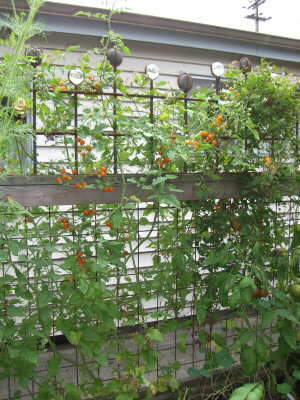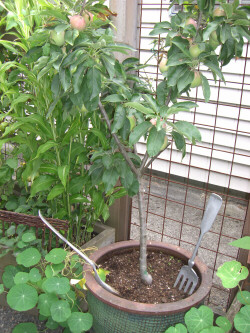The Edible Garden
 Last summer Portland, Oregon was host to the Garden Writer’s Association symposium. More than 600 writers from the east to west coast attended workshops and toured local gardens both public and private. One day of tours took us to several private gardens. The gardens were located in typical city blocks, none very large. Despite their small size, these gardens were inspiring, and it was impressive to see how edible plants incorporated into the landscape could add such beauty to these small spaces.
Last summer Portland, Oregon was host to the Garden Writer’s Association symposium. More than 600 writers from the east to west coast attended workshops and toured local gardens both public and private. One day of tours took us to several private gardens. The gardens were located in typical city blocks, none very large. Despite their small size, these gardens were inspiring, and it was impressive to see how edible plants incorporated into the landscape could add such beauty to these small spaces.There is a movement across the country to “kill the front lawn”. Part of the effort is designed to reduce water and chemical consumption as the typical front yard consumes up to 60 gallons of water per day and 90 million pounds of pesticides are applied to lawns each year. Another part of the movement arose from people’s desire to have fresh home grown food in an urban space. If the idea didn’t start in Portland, the concept was wholeheartedly embraced here. In each of the gardens I visited, there was no space left unadorned. Rows of espalier apple trees create a border around an entirely edible garden, and edibles mingled effortlessly with ornamentals.
Urban agriculture is alive and well in Portland and is a growing trend around the country. While most people don’t think of raising honey bees on their city lots, nothing about Glen Andresen’s garden is ordinary. Every available space in Mr. Andresen’s garden grows food. Peppers and eggplants are a favorite, but his garden grows a little of everything. Even the area flanking the street and the sidewalk in front of his house is home to something edible. It is hard to tell if the curiosity of passers-by comes from the amount and variety of food grown in a small space or by the small paper bags carefully placed to protect each of the apples. The bees happily pollinate the garden while producing the most delicious honey which, by the way, makes for a great pick-me-up from the flu.
Growing food in small spaces is not a new idea. During World War II, everyone was encouraged to grow food to help support the war effort. Every open area was converted and cultivated in order to free up food for the troops. Not only did people feel involved in helping their country, they were connected to the earth and to each other. While tearing out your lawn and planting a vegetable garden may seem radical, it is not the only option for growing your own food in a small space.
 Darcy Daniels, owner of Bloomtown Garden Design & Nursery, combines edibles in her ornamental garden. A large pyramid shaped trellis in her front yard is the support for beautiful purple climbing beans. Raspberries and dwarf apple trees in pretty containers line the side pathway leading to the back yard. Tomatoes intertwined the berries and featured beautiful ripe red fruit. Climbing squash adorned the fence with pretty yellow flowers and beautiful green fruit. The edibles mingled elegantly in the garden providing pretty foliage and beautifully colored fruit. The edibles enjoy some of the sunnier spots while the sheltered areas of the garden showcase lush grouping of colored foliage and texture. The edibles blended in seamlessly with the rest of the garden as Ms. Daniels beautifully incorporated them into the landscape.
Darcy Daniels, owner of Bloomtown Garden Design & Nursery, combines edibles in her ornamental garden. A large pyramid shaped trellis in her front yard is the support for beautiful purple climbing beans. Raspberries and dwarf apple trees in pretty containers line the side pathway leading to the back yard. Tomatoes intertwined the berries and featured beautiful ripe red fruit. Climbing squash adorned the fence with pretty yellow flowers and beautiful green fruit. The edibles mingled elegantly in the garden providing pretty foliage and beautifully colored fruit. The edibles enjoy some of the sunnier spots while the sheltered areas of the garden showcase lush grouping of colored foliage and texture. The edibles blended in seamlessly with the rest of the garden as Ms. Daniels beautifully incorporated them into the landscape.One technique used by Ms. Daniels is planting in containers; the easiest way to start an edible garden. Using containers allows growers to best utilize their Southern exposure as well since they will grow on decks, pavement or when placed in existing planting beds among ornamentals. When planting, don’t be afraid to experiment with new varieties and arrangements. Some varieties such as Romanesco Italia Broccoli are a gorgeous chartreuse color and produce the most intricate and interesting florets. Purple cauliflower is another interesting choice as are peppers, eggplant and some cabbage.
Owning a greenhouse is the best way to effectively utilize a small space. A properly designed greenhouse will provide space for many starts while allowing you to get a jump start on the season. It is possible to grow a significantly larger amount of food in a small space because plants are grown vertically on multiple levels. Some crops will move outside as the frost danger passes, while some may be kept inside until the desired maturity is reached for maximum ornamental effect. Starting indoors also has the add benefit of weed control. When starts are transplanted, weeds become less of an issue because the starts are large enough to effectively compete, reducing your overall effort. If the edibles need protection in the fall or are no longer as attractive, they are easy to move back into the greenhouse for harvest.
Starting plants from seed can also be a significant cost savings. It is estimated that a $100 investment in seeds can product $1,500 worth of crops[iii]. That is a substantial return that is hard to duplicate in this tough economy. Seeds started indoors will have a higher success rate and produce much earlier than their counterparts left to fend for themselves in the elements. Food picked fresh also contains significantly more nutrients than the same food picked days before, shipped many miles and ripened artificially. Fresh food tastes the best as well. Many parents have reported their picky eaters learned to love the vegetables and fruits they helped to grow. It’s hard to replace the pride of serving home grown food to your family.
 When you start planting crops that are pretty among your current landscaping, remember to leave room for some edible flowers. Nasturtiums, pansies and calendula are beautiful and tasty addition to salads. Experiment by adding some edibles in containers along with ornamental plants. There is no right or wrong way to plant, just keep the plant’s sun and water requirements in mind. Once you start with a few containers, who knows, maybe your yard will be the next to go and be replaced with edible landscaping. The only real mistake will be not to start. ~
When you start planting crops that are pretty among your current landscaping, remember to leave room for some edible flowers. Nasturtiums, pansies and calendula are beautiful and tasty addition to salads. Experiment by adding some edibles in containers along with ornamental plants. There is no right or wrong way to plant, just keep the plant’s sun and water requirements in mind. Once you start with a few containers, who knows, maybe your yard will be the next to go and be replaced with edible landscaping. The only real mistake will be not to start. ~Michelle Moore is the General Manager of the Greenhouse Catalog where she has worked with greenhouses for 20 years. Michelle writes and lectures about greenhouse gardening as an Oregon State University Master Gardener and member of Garden Writers Association. Michelle is a Fulbright Scholar and earned an International MBA from Thunderbird, School of Global Management. Michelle and her husband live in Oregon, but they enjoy hints of summer all year in their greenhouse! You can contact Michelle at: michelle.Moore@GreenhouseCatalog.com.
[i] According to the EPA (Environmental Protection Agency), the average family uses 400 gallons of water per day, 30% of that is used outdoors, with 50% of that (60 gallons) used for lawns. The EPA estimates 1/3 of total residential water usage is for landscaping.
[ii] i U.S. Environmental Protection Agency (EPA). 2004. Pesticides Industry Sales and Usage: 2000 and 2001 Market Estimates. EPA-733-R-04-001.
[iii] Interview withScott McGuire's "White Sage Gardens" on Peak Moment TV
Published in Garden and Greenhouse Magazine, www.gardenandgreenhouse.net






